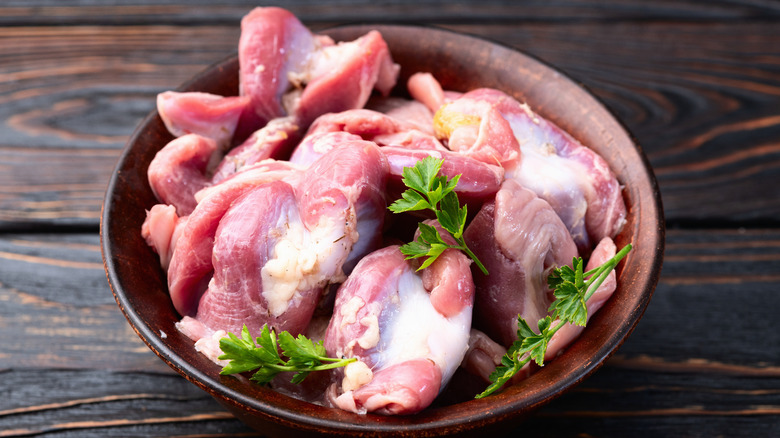How To Remove The Giblets From Your Turkey
There is far more to giblets — that little package of bits and bobs stashed away in your store-bought turkey — than meets the eye. On the surface, giblets are simply a mix of heart, gizzard, liver, neck, and sometimes kidneys. But what this goodie bag can do for your Thanksgiving or Christmas turkey, and all the delicious things served alongside the bird, is where the magic truly lies.
Unlike the other offal that's removed from the turkey before it's packaged and sent to your nearest store, these little flavor nuggets are great to eat and are packed with flavor and nutrients. Giblets are usually used to enhance the taste of your flavorful turkey gravy (and do so, oh so well), with the neck being quite rich and gelatinous. It helps to thicken your gravy, too. With your pack of giblets, you'll be getting vitamins A and B, iron, protein, zinc, copper, taurine, choline, selenium, coQ10, and more. So, be sure not to throw this nutrient-rich packet away.
You'll generally find your giblets (pronounced "ji-bluhts", in case you were wondering) tucked away in the big cavity of your turkey, usually in a little plastic bag. All you need to do to remove them is reach into the cavity and collect the bag. Don't worry, we'll walk you through it.
Finding and removing your giblets
It's easy to forget to remove the giblets before popping the bird into the oven, but it's a vital step in preparing your turkey — even if you don't use them. Once you place that bird in the oven, the heat could melt the bag, which would release harmful chemicals. Thankfully, removing your giblets is the easiest thing in the world.
If your turkey is frozen, you'll want to thaw — or at least partially thaw — it first. This way, the bird and its precious cavity contents soften for easy handling. Make sure the turkey is resting on a sterile surface, and that your hands are clean before you start. Hygiene first! Then, reach into the turkey's rear cavity (located between the legs) and nab that bag of giblets. The neck may be stored separately, so be sure to check for that too. Once you find the giblets, gently pull them out. This is where the extra turkey bits are usually stored, but if you don't find them there, check the front cavity just beside the wings.
To clean them up a bit, you can rinse the giblets before use or just drain the liquids out of the bag. There's no need to rinse your turkey, however. In fact, experts at the U.S. Department of Agriculture (USDA) advise against watering the bird as it could spread foodborne bacteria into your sink and the rest of your kitchen. You'll only need to rinse your turkey if you've brined it.
Giblets are best for turkey gravy
Now that we've removed the giblets, it's time to use those extra pieces. You'll want to cook them up first, so chuck them into a saucepan along with half a cup each of chopped carrots and celery, 1 small chopped onion, 1 bay leaf, half a teaspoon of thyme, and about 5 cups of chicken broth. Bring to a boil and cook for one hour, then strain out the giblets and chop them up. Get as much meat off the neck as possible, then put the meat and broth aside. A little note here: If you're not a big fan of the strong taste of turkey liver, just leave it out.
Remove your turkey from its roasting pan, and then ladle 4 tablespoons of drippings into a fresh saucepan over medium-to-high heat. Pour some broth into the roasting pan and agitate the bits off the bottom before straining that liquid into your saucepan. Slowly add a quarter cup of all-purpose flour to your gravy mixture, stirring constantly to mix in neatly and thus avoid lumps. It should take only a couple minutes to thicken to a roux. Slowly stir the rest of your broth into the roux so it condenses into a gorgeous golden gravy.
If you want to keep your giblets aside to use for something else, like cooking them up as a holiday treat for your pets or making a giblet stew, the best way to store them is in an airtight plastic bag in the fridge for up to two days. If you plan to use them within a month, you can freeze them as well.


